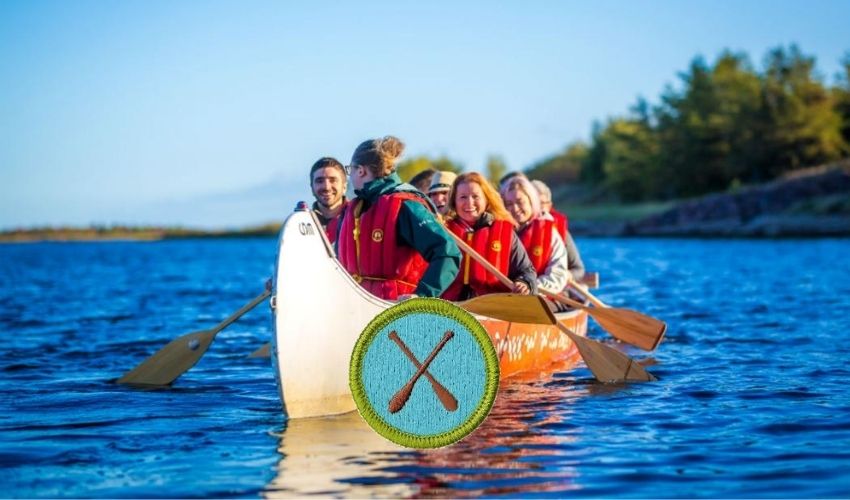I. Introduction to the Canoeing Merit Badge

A. Overview of the Canoeing Merit Badge Program
The Canoeing Merit Badge is a program offered by the Boy Scouts of America that allows scouts to develop skills and knowledge in canoeing. It provides opportunities for scouts to learn about safety, equipment, paddling techniques, trip planning, and environmental stewardship in canoeing.
B. Importance of Canoeing Skills and Knowledge
Canoeing skills and knowledge are important for scouts as they promote physical fitness, outdoor adventure, and water safety. Canoeing develops teamwork, communication, and problem-solving abilities, while also fostering an appreciation for nature and the environment.
C. Understanding the Purpose and Benefits of Earning the Badge
Earning the Canoeing Merit Badge allows scouts to demonstrate their proficiency in canoeing and gain a sense of accomplishment. It provides opportunities for personal growth and teaches valuable skills that can be used throughout their lives, whether for recreational purposes or emergency situations.
II. Requirements for the Canoeing Merit Badge
A. Demonstrate Knowledge of Canoeing Safety
- Understanding Safety Rules and Regulations
Scouts must show an understanding of safety rules and regulations related to canoeing, such as the importance of wearing personal floatation devices (PFDs) and following watercraft right-of-way rules.
- Identifying Personal Floatation Device (PFD) Requirements
Scouts must demonstrate knowledge of PFD requirements and proper usage, including how to properly fit and wear a PFD.
B. Learn Basic Paddling Techniques
- Exploring Different Strokes and Their Applications
Scouts must learn and demonstrate basic paddling strokes, such as the forward stroke, backward stroke, and turning strokes. They should understand when and how to use each stroke effectively.
- Practicing Efficient Forward, Backward, and Turning Techniques
Scouts must practice and demonstrate efficient forward paddling, backward paddling, and turning techniques, showing control and maneuverability in the canoe.
III. Canoeing Equipment and Gear
A. Identifying and Demonstrating Proper Equipment Use
- Understanding Different Types of Canoes and Paddles
Scouts must be able to identify and demonstrate proper usage of different types of canoes and paddles, including their parts and functions.
- Exploring Equipment Maintenance and Storage
Scouts should understand the importance of equipment maintenance and storage, including cleaning, repairing, and proper storage techniques for canoes and paddles.
B. Discussing Essential Gear for Canoeing Trips
- Identifying Safety Equipment, such as Whistle and Throw Rope
Scouts must identify and discuss the essential safety equipment required for canoeing trips, such as a whistle and throw rope, and understand their purposes and proper usage.
- Exploring Camping and Navigation Gear for Canoeing Expeditions
Scouts should explore the necessary camping and navigation gear for canoeing expeditions, including tents, sleeping bags, maps, and compasses, and understand their importance in trip planning.
IV. Canoeing Techniques and Skills
A. Master Basic Canoe Maneuvers
- Practicing Efficient Steering and Turning Techniques
Scouts must practice and demonstrate efficient steering and turning techniques, showing control and precision in maneuvering the canoe.
- Demonstrating Effective Bracing and Recovery Strokes
Scouts should demonstrate effective bracing and recovery strokes to maintain balance and stability in the canoe in various situations, such as encountering waves or rough water.
B. Learn Advanced Canoeing Techniques
- Exploring Advanced Paddling Strokes, such as Draw and Pry
Scouts should explore and demonstrate advanced paddling strokes, such as the draw stroke and pry stroke, which are used for precise maneuvering and control in different water conditions.
- Understanding Techniques for Canoeing in Different Water Conditions
Scouts must understand and discuss techniques for canoeing in different water conditions, such as calm lakes, fast-flowing rivers, and choppy waves, including appropriate strokes and adjustments for stability and control.
V. Trip Planning and Safety Considerations
A. Understanding the Importance of Trip Planning
- Exploring Factors to Consider when Planning a Canoeing Trip
Scouts must understand the importance of proper trip planning, including considering factors such as weather conditions, waterway characteristics, camping options, and emergency preparedness.
- Identifying Resources for Trip Planning and Navigation
Scouts should identify resources for trip planning and navigation, such as maps, guidebooks, websites, and local authorities or organizations that provide information on waterway conditions, access points, and regulations.
B. Discussing Emergency Preparedness and Rescue Techniques
- Understanding Common Canoeing Emergencies and Their Solutions
Scouts must understand common canoeing emergencies, such as capsizing, entrapment, or injuries, and discuss appropriate solutions and rescue techniques for each situation.
- Practicing Self-Rescue and Assisting Others in Water Rescue Scenarios
Scouts should practice self-rescue techniques and demonstrate the ability to assist others during water rescue scenarios, including using throw ropes, performing rescues from a capsized canoe, and providing first aid.
VI. Environmental Stewardship in Canoeing
A. Promoting Leave No Trace Principles
- Exploring Camping and Litter Management Practices
Scouts should understand and discuss the importance of minimizing their impact on the environment while canoeing, including proper camping practices and minimizing litter or waste.
- Understanding the Importance of Protecting Waterways and Wildlife
Scouts must understand the importance of protecting waterways and wildlife, including avoiding disturbance of natural habitats, respecting wildlife, and practicing responsible behavior while canoeing.
B. Discussing Conservation and Preservation Efforts
- Identifying Local Organizations and Initiatives for River Conservation
Scouts should identify local organizations and initiatives that work towards the conservation and preservation of rivers and waterways, and discuss ways in which they can contribute or participate in these efforts.
- Exploring Opportunities to Contribute to Environmental Protection
Scouts should explore opportunities to actively contribute to environmental protection, such as participating in river clean-up activities, educating others about the importance of preserving waterways, or supporting conservation projects.
The Canoeing Merit Badge provides Scouts with valuable skills and knowledge in canoeing, safety, trip planning, and environmental stewardship. By fulfilling the badge’s requirements, Scouts develop proficiency in paddling techniques, equipment use, trip planning, and conservation efforts. Earning the Canoeing Merit Badge not only promotes outdoor skills but also fosters a deeper appreciation for nature and the importance of responsible recreation.
